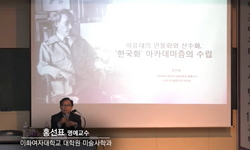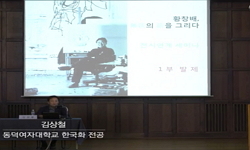장대천(張大千, 1899-1983)은 중국 근현대기를 대표하는 작가이다. 그는 1927년 내한하여 금강산을 유람하면서 한국과 인연을 맺었다. 해방 이후 대만과의 활발한 문화 교류로 동시대 작가들이 ...
http://chineseinput.net/에서 pinyin(병음)방식으로 중국어를 변환할 수 있습니다.
변환된 중국어를 복사하여 사용하시면 됩니다.
- 中文 을 입력하시려면 zhongwen을 입력하시고 space를누르시면됩니다.
- 北京 을 입력하시려면 beijing을 입력하시고 space를 누르시면 됩니다.

장대천(張大千, 1899-1983)과20세기 후반 한국화 = Zhang Daiqian(張大千, 1899-1983) and Korean painting in the late 20th century
한글로보기https://www.riss.kr/link?id=A109473875
-
저자
송희경 (겸재정선미술관)
- 발행기관
- 학술지명
- 권호사항
-
발행연도
2024
-
작성언어
Korean
-
주제어
장대천 ; 발묵 ; 발채 ; 한국화 ; 송수남 ; 홍석창 ; 송계일 ; Zhang Daiqian ; ink and color development ; Korean painting ; Song Soonam ; Hong Sukchang ; Song Kyeil
-
등재정보
KCI등재
-
자료형태
학술저널
-
수록면
25-48(24쪽)
- 제공처
-
0
상세조회 -
0
다운로드
부가정보
국문 초록 (Abstract)
한국화 작가들이 수용한 장대천의 조형성은 대부분 발묵과 발채에 집중되었다. 이를 도입한 회화는 1970년대 중반부터 확산되어 1980년대 중반까지 지속되었다. 장대천의 조형성이 수용된 산수화는 당시 국내 유행한 사경산수화와 다른 양상을 보여주었다. 이러한 창작을 선택한 작가층도 20대 후반부터 40대 초반에 해당하는 청년 작가들이었다. 이제 막 중견으로 자리매김하고자 도약하는 작가들에게 장대천의 발묵, 발채 산수화가 참신한 해법을 제공한 것이다.
이렇듯 장대천 산수화의 조형성은 동양의 전통과 서양의 새로움을 동시에 추구하여 현대성을 모색하고자 노력하는 한국화 작가들에게 적절한 대안으로 작용했다. 나아가 일제강점기 이후 다소 약화된 중국회화의 영향력이 20세기 후반 한국화 분야에서 어떻게 지속되는지 알려주는 단서가 되었다.
장대천(張大千, 1899-1983)은 중국 근현대기를 대표하는 작가이다. 그는 1927년 내한하여 금강산을 유람하면서 한국과 인연을 맺었다. 해방 이후 대만과의 활발한 문화 교류로 동시대 작가들이 국내 알려질 때 장대천의 존재도 부각되었다. 한국에서 동시대 대만 회화의 인지도가 높아졌지만 장대천만큼 20세기 후반 한국화 분야에 영향을 끼친 인물을 찾아볼 수 없다. 장대천 회화가 한국화 작가들에게 신선한 매력으로 작용했음을 알려주는 단서이다.
한국화 작가들이 수용한 장대천의 조형성은 대부분 발묵과 발채에 집중되었다. 이를 도입한 회화는 1970년대 중반부터 확산되어 1980년대 중반까지 지속되었다. 장대천의 조형성이 수용된 산수화는 당시 국내 유행한 사경산수화와 다른 양상을 보여주었다. 이러한 창작을 선택한 작가층도 20대 후반부터 40대 초반에 해당하는 청년 작가들이었다. 이제 막 중견으로 자리매김하고자 도약하는 작가들에게 장대천의 발묵, 발채 산수화가 참신한 해법을 제공한 것이다.
이렇듯 장대천 산수화의 조형성은 동양의 전통과 서양의 새로움을 동시에 추구하여 현대성을 모색하고자 노력하는 한국화 작가들에게 적절한 대안으로 작용했다. 나아가 일제강점기 이후 다소 약화된 중국회화의 영향력이 20세기 후반 한국화 분야에서 어떻게 지속되는지 알려주는 단서가 되었다.
다국어 초록 (Multilingual Abstract)
Most of Zhang Daiqian's formative qualities accepted by Korean painting artists were focused on ink and color development. Paintings that introduced it spread from the mid-1970s and continued until the mid-1980s. The landscape paintings in which Zhang Daiqian's formative qualities were accepted showed a different aspect from the sutra landscape paintings that were popular in Korea at the time. The painters who chose this type of creation were young painters in their late 20s to early 40s. Zhang Daiqian's ink and color development landscape paintings provided a novel solution to artists who are just making a leap forward to establish themselves as mid-level artists.
In this way, the formative nature of Zhang Daiqian's landscape paintings served as an appropriate alternative for Korean painting artists who sought modernity by simultaneously pursuing Eastern tradition and Western novelty. Furthermore, it served as a clue to how the influence of Chinese painting, which had weakened somewhat after the Japanese colonial period, continued in the field of Korean painting in the late 20th century.
Zhang Daiqian(張大千, 1899-1983) is a representative painter of modern and contemporary China. He visited Korea in 1927 and formed a relationship with Korea while touring Mt. Geumgang. After liberation, when contemporary painters became known domes...
Zhang Daiqian(張大千, 1899-1983) is a representative painter of modern and contemporary China. He visited Korea in 1927 and formed a relationship with Korea while touring Mt. Geumgang. After liberation, when contemporary painters became known domestically due to active cultural exchanges with Taiwan, the existence of Zhang Daiqian was also highlighted. Although the awareness of contemporary Taiwanese painting has increased in Korea, no figure has had as much influence on the field of Korean painting in the late 20th century as Zhang Daiqian. This is a clue that Zhang Daiqian's paintings served as a refreshing attraction to Korean painting artists.
Most of Zhang Daiqian's formative qualities accepted by Korean painting artists were focused on ink and color development. Paintings that introduced it spread from the mid-1970s and continued until the mid-1980s. The landscape paintings in which Zhang Daiqian's formative qualities were accepted showed a different aspect from the sutra landscape paintings that were popular in Korea at the time. The painters who chose this type of creation were young painters in their late 20s to early 40s. Zhang Daiqian's ink and color development landscape paintings provided a novel solution to artists who are just making a leap forward to establish themselves as mid-level artists.
In this way, the formative nature of Zhang Daiqian's landscape paintings served as an appropriate alternative for Korean painting artists who sought modernity by simultaneously pursuing Eastern tradition and Western novelty. Furthermore, it served as a clue to how the influence of Chinese painting, which had weakened somewhat after the Japanese colonial period, continued in the field of Korean painting in the late 20th century.
동일학술지(권/호) 다른 논문
-
허(虛)의 미의식으로 본 ‘빛’의 회화적 표현-연구자의 작품을 중심으로-
- 동서미술문화학회
- 허선정
- 2024
- KCI등재
-
인지기능이 다른 노인의 반복적 미술활동이 우울감에 미치는 영향 비교 연구 -주관적 인지저하, 경도 인지저하,인지장애 대상자 중심으로-
- 동서미술문화학회
- 이경연
- 2024
- KCI등재
-
- 동서미술문화학회
- 홍인국
- 2024
- KCI등재
-
초기 잭슨 폴록 드로잉과 작품에 나타난 한국적 형상 분석
- 동서미술문화학회
- 채정균
- 2024
- KCI등재




 DBpia
DBpia





